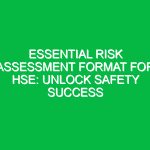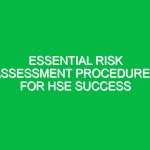Introduction to Toolbox Talks
Hello team! Today, we’re going to have an important Toolbox Talk about being Ready For Work. This isn’t just a casual chat; it’s a crucial part of our commitment to health, safety, and Environment (HSE). As we gear up for another day on the job, I want to ensure that each of you understands the significance of being prepared and aware of the Best Practices to keep ourselves and our colleagues safe while working.
Why Being Ready For Work Matters
Being Ready For Work means that we are not only physically prepared to start our tasks but also mentally and emotionally equipped to handle the challenges that may arise. When we talk about HSE, we emphasize the importance of Safety culture, which is built on the foundation of preparedness. A well-prepared team is less likely to face accidents or incidents that could jeopardize their Safety or the safety of those around them.
The Importance of Toolbox Talks
Toolbox talks are brief, informal discussions that focus on specific safety issues related to our work environment. They serve several purposes:
- To raise awareness about potential Hazards.
- To share Best Practices and safety protocols.
- To encourage employee participation and feedback on safety matters.
- To reinforce our organization’s commitment to safety.
By engaging in these talks, we can enhance our collective understanding of safety protocols and create a culture where everyone feels responsible for maintaining a safe workplace.
Key Components of Being Ready For Work
Now, let’s delve into what it truly means to be Ready For Work. This encompasses several key components:
1. Mental Preparedness
Before starting your shift, it’s crucial to be mentally prepared. This means being focused and alert. Here are some tips to ensure your mental readiness:
- Arrive on time and avoid rushing, which can lead to oversight.
- Take a moment to clear your mind – leave personal issues outside the workplace.
- Review the day’s tasks and any safety protocols relevant to them.
For example, if you are scheduled to operate heavy machinery, ensure you are mentally focused and ready to respond to any unexpected situations.
2. Physical Preparedness
Your physical state is equally important. Being in good health and having the appropriate Personal Protective Equipment (PPE) is vital. Consider the following:
- Ensure that you are well-rested before your shift.
- Wear the correct PPE for your specific tasks, such as helmets, gloves, or goggles.
- Be aware of any physical limitations you might have that could affect your work.
For instance, if someone is feeling unwell or fatigued, it’s essential to speak up and consider taking a break or consulting with a supervisor.
3. Knowledge of Tasks and Hazards
Understanding what you will be doing during your shift and the potential hazards involved is crucial. Make sure you:
- Review job safety analyses (JSAs) related to your tasks.
- Ask questions if you are unsure about any Procedures or Safety Measures.
- Participate actively in discussions about any safety concerns.
A scenario to consider: if you are about to start a task that involves working at heights, ensure that you are familiar with the Fall Protection systems in place and that they are in working order.
4. Communication
Effective communication is a cornerstone of safety. Here’s how to ensure clear communication:
- Always report any unsafe conditions or behaviors you observe.
- Engage in pre-shift meetings to discuss the day’s operations and safety concerns.
- Encourage your peers to share their thoughts and experiences.
For example, if a colleague mentions a concern about equipment malfunction, take it seriously and investigate the issue further.
Potential Hazards and Safety Considerations
Understanding the hazards associated with your work is paramount. Here are some common hazards you might encounter:
1. Environmental Hazards
Be aware of the environment in which you are working. Weather conditions, such as rain or extreme heat, can affect your safety. Always check the weather forecast and plan accordingly.
2. Mechanical Hazards
Working with machinery and tools presents various risks. Ensure that all equipment is properly maintained and that you are trained to use it safely. Regularly inspect tools before use.
3. Chemical Hazards
If you work with chemicals, understand the Material Safety Data Sheets (MSDS) for those substances. Proper handling and storage practices are vital to prevent accidents.
Best Practices for a Safe Work Environment
To create a safe work environment, consider adopting these best practices:
1. Conduct Regular Safety Audits
Regularly inspect your workplace for potential hazards. This proactive approach can help identify issues before they become problematic.
2. Participate in Safety Training
Engage in all safety training sessions provided by your employer. Keep your skills and knowledge updated to ensure compliance with current safety Standards.
3. Foster a Safety Culture
Encourage open dialogue about safety among your peers. Share experiences and lessons learned to promote collective responsibility for safety.
4. Use Technology Wisely
Leverage available technology, such as safety apps and monitoring devices, to enhance Safety Measures and reporting.
Regulations and Standards for HSE
Understanding relevant Regulations and standards is essential for compliance and safety. Familiarize yourself with:
1. Occupational Safety and Health Administration (OSHA)
osha provides guidelines and regulations to ensure Workplace Safety. Adhering to these standards not only protects you but also your employer from legal repercussions.
2. Company Policies
Each organization has its safety policies and procedures. Make sure you are well-versed in your company’s specific guidelines and protocols.
Interactive Discussion
Before we conclude, let’s open the floor for discussion. Here are some questions to consider:
- What are some challenges you face in being Ready For Work?
- Can you share any experiences where being unprepared led to a close call or incident?
- How can we improve our communication regarding safety on the job site?
Your input is invaluable, and sharing experiences can lead to improvements in our safety practices.
Conclusion
In closing, being Ready For Work is a collective responsibility that requires our commitment and awareness. By following the tips discussed today, participating in toolbox talks, and maintaining an open dialogue about safety, we can significantly reduce the risk of accidents and create a safer working environment for everyone.
Thank you all for your attention and dedication to safety. Let’s make it a great, safe day at work!


